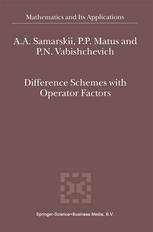

Most ebook files are in PDF format, so you can easily read them using various software such as Foxit Reader or directly on the Google Chrome browser.
Some ebook files are released by publishers in other formats such as .awz, .mobi, .epub, .fb2, etc. You may need to install specific software to read these formats on mobile/PC, such as Calibre.
Please read the tutorial at this link: https://ebookbell.com/faq
We offer FREE conversion to the popular formats you request; however, this may take some time. Therefore, right after payment, please email us, and we will try to provide the service as quickly as possible.
For some exceptional file formats or broken links (if any), please refrain from opening any disputes. Instead, email us first, and we will try to assist within a maximum of 6 hours.
EbookBell Team

4.4
42 reviewsTwo-and three-level difference schemes for discretisation in time, in conjunction with finite difference or finite element approximations with respect to the space variables, are often used to solve numerically non stationary problems of mathematical physics. In the theoretical analysis of difference schemes our basic attention is paid to the problem of sta bility of a difference solution (or well posedness of a difference scheme) with respect to small perturbations of the initial conditions and the right hand side. The theory of stability of difference schemes develops in various di rections. The most important results on this subject can be found in the book by A.A. Samarskii and A.V. Goolin [Samarskii and Goolin, 1973]. The survey papers of V. Thomee [Thomee, 1969, Thomee, 1990], A.V. Goolin and A.A. Samarskii [Goolin and Samarskii, 1976], E. Tad more [Tadmor, 1987] should also be mentioned here. The stability theory is a basis for the analysis of the convergence of an approximative solu tion to the exact solution, provided that the mesh width tends to zero. In this case the required estimate for the truncation error follows from consideration of the corresponding problem for it and from a priori es timates of stability with respect to the initial data and the right hand side. Putting it briefly, this means the known result that consistency and stability imply convergence.